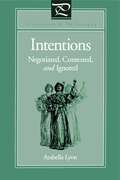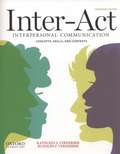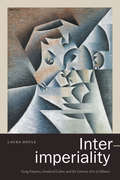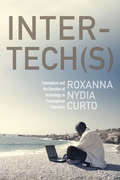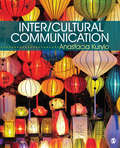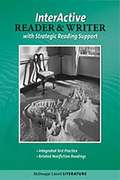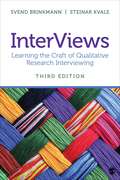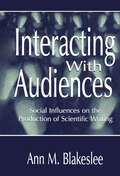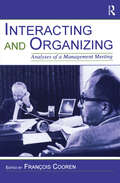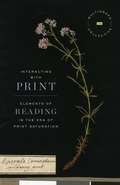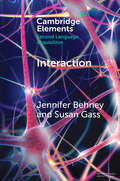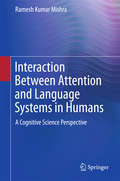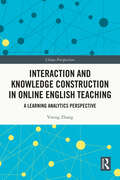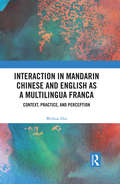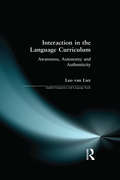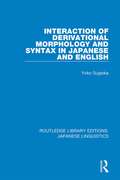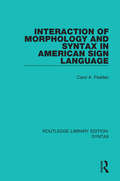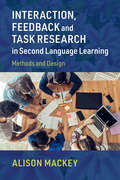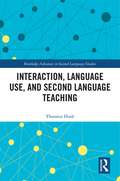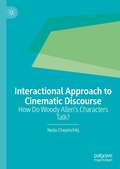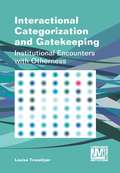- Table View
- List View
Intentions: Negotiated, Contested, and Ignored (Literature and Philosophy)
by Arabella LyonThe relationship between an author's and an audience's intentions is complex but need not preclude mutual engagement. This philosophical investigation challenges existing literary and rhetorical perspectives on intention and offers a new framework for understanding the negotiation of meaning. It describes how an audience's intentions affect their interpretations, shows how audiences negotiate meaning when faced with a writer's undecipherable intentions, and defines the scope of understanding within rhetorical situations.Introducing a concept of intention into literary analysis that supersedes existing rhetorical theory, Arabella Lyon shows how the rhetorics of I. A. Richards, Wayne Booth, and Stanley Fish, as well as the hermeneutics of Hans-Georg Gadamer, fail to account for the complex interactions of author and audience. Using Kenneth Burke's concepts of form, motive, and purpose, she builds a more complex notion of intention than those usually found in literary studies, then employs her theory to describe how philosophers read Wittgenstein's narratives, metaphors, and reversals in argument.Lyon argues that our differences in intention prevent consistency in interpretations but do not stop our discussions, deliberations, and actions. She seeks to acknowledge difference and the communicative problems it creates while demonstrating that difference is normal and does not end our engagement with each other.Intentions combines recent work in philosophy, literary criticism, hermeneutics, and rhetoric in a highly imaginative way to construct a theory of intention for a postmodern rhetoric. It recovers and renovates central concepts in rhetorical theory—not only intention but also deliberation, politics, and judgment.
Inter- und transmediale Ästhetik bei Josef Winkler (Kontemporär. Schriften zur deutschsprachigen Gegenwartsliteratur #8)
by Anke Bosse Christina Glinik Elmar LenhartDas Ringen mit und um Sprache und seine Verschränkung mit Leiblichkeit sind zentrale Themen Josef Winklers. Die existentiellen sowie materiellen und medialen Aspekte des Schreibens bilden den Kern seiner performativen Poetologie. Sie ist seit von Anfang an sowohl intertextuell als auch inter- und transmedial geprägt und strahlt über Literatur hinaus in eine allgemeine Ästhetik. Auf Basis eines breiten kulturanthropologischen Medienbegriffs, der von Sprache als audiovisuellem Archimedium des Menschen ausgeht, zeichnen die Beiträge des Bandes anhand konkreter Beispiele aus Winklers Werk und Schreiben intertextuelle Bezüge sowie intermediale Verbindungen zu Film, Fotografie, bildender Kunst, Theater und Zirkus nach. Oder aber sie verfolgen die transmedialen Umwandlungen, die im Verlauf des Schreib- und Publikationsprozesses von der Handschrift bis zum Buch führen – bis hin zu der Frage, wie Literatur und Schreiben ausstellbar sein können. Dabei werden poetologisch-produktionsästhetische Ansätze auf wirkungsästhetische Ziele des Autors und damit auf seine Leserinnen und Leser hin geöffnet.
Inter-Act: Interpersonal Communication Concepts, Skills, and Contexts (Thirteenth Edition)
by Rudolph F. Verderber Kathleen S. VerderberDesigned to help students understand communication processes in relationships and develop specific skills needed to create and maintain healthy ones, Inter-Act: Interpersonal Communication Concepts, Skills, and Contexts, Thirteenth Edition, retains the features that have made this book so successful: a theory driven skills-based focus, an accessible tone and presentation, and a multitude of useful pedagogical tools. For this edition, Joseph Mazer of Clemson University (whose scholarship includes original research on social media) authored much of the new and unique social media content and Brant Burleson and Erina MacGeorge of Purdue helped to update the scholarship, while maintaining the skills-based approach that this text is known for. Lively and well-written, Inter-Act features numerous activities that enable students to relate their everyday experiences to their studies in communication. It also clearly illustrates how cultural, racial, and gender differences-as well as electronically mediated messages-alter what we should do to communicate effectively. With a strong focus on the importance of ethics, this leading text encourages students to develop their analytical abilities as they think critically about key concepts in interpersonal communication.
Inter-imperiality: Vying Empires, Gendered Labor, and the Literary Arts of Alliance
by Laura DoyleIn Inter-imperiality Laura Doyle theorizes the co-emergence of empires, institutions, language regimes, stratified economies, and literary cultures over the longue durée. Weaving together feminist, decolonial, and dialectical theory, she shows how inter-imperial competition has generated a systemic stratification of gendered, racialized labor, while literary and other arts have helped both to constitute and to challenge this world order. To study literature is therefore, Doyle argues, to attend to world-historical processes of imaginative and material co-formation as they have unfolded through successive eras of vying empires. It is also to understand oral, performed, and written literatures as power-transforming resources for the present and future. To make this case, Doyle analyzes imperial-economic processes across centuries and continents in tandem with inter-imperially entangled literatures, from A Thousand and One Nights to recent Caribbean fiction. Her trenchant interdisciplinary method reveals the structural centrality of imaginative literature in the politics and possibilities of earthly life.
Inter-tech(s): Colonialism and the Question of Technology in Francophone Literature
by Roxanna Nydia CurtoChallenging the notion that francophone literature generally valorizes a traditional, natural mode of being over a scientific, modern one, Inter-tech(s) proposes a new understanding of the relationship between France and its former colonies in Africa and the Caribbean by exploring how various postindependence authors depict technology as a mediator between them. By providing the first comprehensive study of the representation of technology in relation to colonialism and postcolonialism in francophone literature, Roxanna Curto shows the extent to which the authors promote modernization and social progress.Curto traces this trend in the wake of decolonization, when a series of important francophone African and Caribbean writers began to portray modern technology as a liberating, democratizing force, capable of erasing the hierarchies of the old colonial order and promoting economic development. Beginning with the founders of Négritude Aimé Césaire and Léopold Sédar Senghor and continuing with Frantz Fanon, postindependence novelists such as Ousmane Sembène, and contemporary writers such as Édouard Glissant, the author shows how these francophone writers champion the transfer of technology from the metropolis to the former colonies as a means of integrating their cultures into a global community, thus paving the way for modernization and technological development.
Inter/Cultural Communication: Representation and Construction of Culture
by Anastacia KuryloToday, students are more familiar with other cultures than ever before because of the media, Internet, local diversity, and their own travels abroad. As such, traditional intercultural communication textbooks which focus solely on the ′differences′ approach aren′t truly effective for today′s students, nor for this field′s growth. Using a social constructionist framework—which explores how culture is constructed and produced in the moments in which it is experienced—Inter/Cultural Communication provides today′s students with a rich understanding of how culture and communication affect and effect each other.Inter/Cultural Communication improves upon current textbooks in four significant ways: (1) It provides a differences approach and a social constructionist approach; (2) It explores the consequences of cultural moments on immediate communication and on larger scale social issues; (3) It is descriptive, not prescriptive, of how culture is communicated; and (4) It introduces intercultural topics, rather than interpersonal topics. Weaving multiple approaches together in order to provide students with a comprehensive understanding of and appreciation for the diversity of cultural and intercultural communication, this text allows them to become more aware of their own identities and how powerful those identities can be in facilitating change—both in their own lives and in the lives of others. In addition, the book will help students deal with unfamiliar cultures and understand those with whom they come in contact when they travel, in their communities, in the workplace, in their home, and online.
Inter/Cultural Communication: Representation and Construction of Culture
by Anastacia KuryloToday, students are more familiar with other cultures than ever before because of the media, Internet, local diversity, and their own travels abroad. As such, traditional intercultural communication textbooks which focus solely on the ′differences′ approach aren′t truly effective for today′s students, nor for this field′s growth. Using a social constructionist framework—which explores how culture is constructed and produced in the moments in which it is experienced—Inter/Cultural Communication provides today′s students with a rich understanding of how culture and communication affect and effect each other.Inter/Cultural Communication improves upon current textbooks in four significant ways: (1) It provides a differences approach and a social constructionist approach; (2) It explores the consequences of cultural moments on immediate communication and on larger scale social issues; (3) It is descriptive, not prescriptive, of how culture is communicated; and (4) It introduces intercultural topics, rather than interpersonal topics. Weaving multiple approaches together in order to provide students with a comprehensive understanding of and appreciation for the diversity of cultural and intercultural communication, this text allows them to become more aware of their own identities and how powerful those identities can be in facilitating change—both in their own lives and in the lives of others. In addition, the book will help students deal with unfamiliar cultures and understand those with whom they come in contact when they travel, in their communities, in the workplace, in their home, and online.
InterActive Reader & Writer with Strategic Reading Support
by Mcdougal LittellThe InterActive Reader & Writer is a literature book to mark on, write in, and make your own. As you will see, this book helps you become an active reader. It also helps you become a better writer.
InterActive Reader & Writer with Strategic Reading Support, Grade 8
by Arthur N. Applebee Jim Burke Janet AllenNIMAC-sourced textbook
InterViews: Learning the Craft of Qualitative Research Interviewing
by Steinar Kvale Svend BrinkmannThe Third Edition of Brinkmann and Kvale’s InterViews: Learning the Craft of Qualitative Research Interviewing, offers readers comprehensive and practical insight into the many factors that contribute to successful interviews. The book invites readers on a journey through the landscape of interview research, providing the "hows" and "whys" of research interviewing, and outlines paths for students to follow on the way to research goals. Thoroughly updated to account for all recent developments in qualitative interviewing, the New Edition expands its focus on the practical, epistemological, and ethical issues involved in interviewing, while maintaining the fluid and logical structure it has become known for throughout the text.
Interacting With Audiences: Social Influences on the Production of Scientific Writing (Rhetoric, Knowledge, and Society Series)
by Ann M. BlakesleeThis distinctive monograph examines the dynamic rhetorical processes by which scientists shape, negotiate, and position their work within an interdisciplinary community. Author Ann M. Blakeslee studies the everyday rhetorical practices of a group of condensed matter theoretical physicists, and presents here the first substantial qualitative study of the planning and implementation of discursive practices by a group of scientists. This volume also represents one of the first studies to use situated cognition and learning theory to study how knowledge of a domain's discursive practices is acquired by newcomers. Unlike previous studies of scientists' rhetorical practices, which have focused primarily on the finished or published texts, Blakeslee's involvement with the physicists as they engaged in the composing processes--from jotting down planning notes through publishing a scientific paper--suggests an alternative view of audience based on cooperative interaction between authors and their interlocutors. From this innovative perspective, functional knowledge of audiences comes only by entering into some community of practice, in which readers also become self-defining interlocutors and even participants in joint projects. Blakeslee's research follows the physicists' work into communal, interactive dynamics, looking at their overt attempts to get feedback from members of their audiences, what that feedback was, and how they responded to it. This work addresses and extends a model for audience analysis that consists of two primary operations: getting to know and understand one's interlocutors, and determining how to reach and influence them. In doing so, it offers important insights into the dissemination of scientific information, and thus will be of great interest to scholars and students in the areas of rhetoric of science and technology, composition, rhetorical theory, and scientific writing.
Interacting and Organizing: Analyses of a Management Meeting (Routledge Communication Series)
by François CoorenThis work provides an exceptional case study, shedding light onto the functioning of an actual corporate board of directors. It presents analysis of a series of corporate management meetings shown in the 1974 documentary film, Corporation: After Mr. Sam. The film chronicles the discussion and communication processes as a company considers how to replace its president, and it serves as a unique opportunity for analysis of real-world organizational discourse. With an impressive list of prominent contributors, Interacting and Organizing: Analyses of a Management Meeting employs the dual perspectives of organizational communication and language and social interaction (LSI) to examine the film. It is arranged around specific topics, analyzed separately by organizational communication and LSI scholars. Editor François Cooren provides an introduction for each topic, and a comparison and synthesis conclude each part. Readers will appreciate the information presented, as it is an arena typically off-limits to outside eyes. The transcript of the film is included as an appendix to the volume. This volume is appropriate for use in advanced courses and seminars in organizational communication, LSI, management, and organizational behavior. With its distinctive approach to studying the film's content, it will be invaluable to scholars, researchers, and graduate students in organizational communication, LSI, and management.
Interacting with Print: Elements of Reading in the Era of Print Saturation (The Multigraph Collective)
by The Multigraph CollectiveA thorough rethinking of a field deserves to take a shape that is in itself new. Interacting with Print delivers on this premise, reworking the history of print through a unique effort in authorial collaboration. The book itself is not a typical monograph—rather, it is a “multigraph,” the collective work of twenty-two scholars who together have assembled an alphabetically arranged tour of key concepts for the study of print culture, from Anthologies and Binding to Publicity and Taste. Each entry builds on its term in order to resituate print and book history within a broader media ecology throughout the eighteenth and nineteenth centuries. The central theme is interactivity, in three senses: people interacting with print; print interacting with the non-print media that it has long been thought, erroneously, to have displaced; and people interacting with each other through print. The resulting book will introduce new energy to the field of print studies and lead to considerable new avenues of investigation.
Interaction (Elements in Second Language Acquisition)
by Jennifer Behney Susan GassThis Element in the Cambridge Elements in Second Language Acquisition series examines the role of interaction in Second Language Acquisition research, with a focus on the cognitive interactionist approach. The Element describes the major branches of the field, considering the importance of conversational interaction in both the cognitive interactionist framework as well as in sociocultural approaches to second language learning. The authors discuss the key concepts of the framework, including input, negotiation for meaning, corrective feedback, and output. The key readings in the field and the emphases of current and future research are explained. Finally, the authors describe the pedagogical implications that the cognitive interactionist approach has had on the teaching of second languages.
Interaction Between Attention and Language Systems in Humans
by Ramesh Kumar MishraThis original volume examines the interface between attentional and linguistic processes in humans from the perspectives of psycholinguistics and cognitive science. It systematically explores how autonomy and automaticity are reflected during language processing in a variety of situations. A true, mechanistic explanation of how humans process language would require a complete understanding of the interface language has with important cognitive systems like attention, memory, as well as with vision. Interdisciplinary work in this area has so far not been able to generate a substantial theoretical position on this issue. This volume therefore looks at different language processing domains, such as speaking, listening, reading, as well as discourse and text processing, to evaluate the role attention plays in such performances; and also at how often linguistic inputs affect attentional processing. In this sense, it proposes that the attention--language interface is bidirectional. It also considers applied issues like language disorders, bilingualism and illiteracy, where the attention--language interface seems especially relevant as a theoretical apparatus for research investigations. Therefore, this volume brings closer theoretical explanations from the language sciences and cognitive sciences. It argues that language processing is multi-modal in its very essence and many conceptual structures in language evolve out of a complex interplay among participating cognitive systems such as attention and memory, supported by vision and audition.
Interaction and Knowledge Construction in Online English Teaching: A Learning Analytics Perspective (China Perspectives)
by Yining ZhangWithin a Chinese English as a Foreign Language (EFL) learning context, this book investigates how teachers and learners interacted and articulated their understanding of English for Research Publication Purposes (ERPP)-related knowledge in a synchronous EFL classroom.The outbreak of the COVID-19 Pandemic changed the way people receive education, causing an almost overnight switch from on-campus instruction to distance learning. Under the use of three different learning analytics approaches, this book has moved beyond the usual descriptive understanding of the online learning process to an in-depth exploratory and inferential analysis of the entities, structures, relations, and processes of learning. The findings enrich current understandings of the complexity of ERPP teaching and learning in synchronous learning contexts. These findings also drive us to rethink and reshape the way ERPP instruction is delivered post-pandemic. An essential read for students and scholars of education and academic English. This book will also be a vital source for researchers in the field of learning analytics, data analysis, and data interpretation in language teaching and learning.
Interaction and Knowledge Construction in Online English Teaching: A Learning Analytics Perspective (ISSN)
by Yining ZhangWithin a Chinese English as a Foreign Language (EFL) learning context, this book investigates how teachers and learners interacted and articulated their understanding of English for Research Publication Purposes (ERPP)-related knowledge in a synchronous EFL classroom.The outbreak of the COVID-19 pandemic changed the way people receive education, causing an almost overnight switch from on-campus instruction to distance learning. Under the use of three different learning analytics approaches, this book has moved beyond the usual descriptive understanding of the online learning process to an in-depth exploratory and inferential analysis of the entities, structures, relations, and processes of learning. The findings enrich current understandings of the complexity of ERPP teaching and learning in synchronous learning contexts. These findings also drive us to rethink and reshape the way ERPP instruction is delivered post-pandemic.An essential read for students and scholars of education and academic English. This book will also be a vital source for researchers in the field of learning analytics, data analysis, and data interpretation in language teaching and learning.
Interaction in Mandarin Chinese and English as a Multilingua Franca: Context, Practice, and Perception
by Weihua ZhuInteraction in Mandarin Chinese and English as a Multilingua Franca: Context, Practice, and Perception proposes a model of context, practice, and perception and raises awareness of the importance of understanding language use and perception in context in order to avoid intercultural communication misunderstandings. This book provides an overview of previous research on the pragmatics of Chinese and English as a multilingua franca in multilingual contexts. It argues that context is socioculturally shaped, interactionally constructed, and personally related. Context can influence and be established by the practice and perception of communicative acts. This book also combines the proposed model with the discursive-interactional approach to uncover the interplay of context, practice, and perception of extended concurrent speech for strong disagreement by native Chinese speakers in spontaneous conversations in Mandarin and English as a multilingua franca.
Interaction in the Language Curriculum: Awareness, Autonomy and Authenticity (Applied Linguistics and Language Study)
by Leo Van LierInteraction in the Language Curriculum offers an innovative theory of language education integrating curriculum practice, research and teaching. It emphasises the interdependence of knowledge and values and stresses the central importance of learning as a social process.Leo van Lier argues that moral as well as intellectual and practical principles must underlie curriculum development and everyday teaching, captured in his triple focus on Awareness, Autonomy, and Authenticity. In addition to its rich grounding in language education practice, the book draws support for his position from diverse sources in sociology, philosophy and cognitive science, from the work of Bourdieu, Giddens, Wittgenstein, Peirce, Vygotsky, Bakhtin, and Dewey. In the current broadening context of language education this study makes an important contribution to research. It presents a coherent philosophical theory as well as considering practical issues in implementation of a new language curriculum. As such, it will be of great benefit to teachers, applied linguists and educationalists generally.
Interaction of Derivational Morphology and Syntax in Japanese and English (Routledge Library Editions: Japanese Linguistics #3)
by Yoko SugiokaOriginally published in 1986, this book discusses how the proper boundary between the lexicon and syntax should be defined and examines various word formation processes in Japanese and English which involve some interaction of morphology and syntax. It also questions the plausibility of the lexicalist hypothesis as a theory of universal grammar. It proposes a rule typology approach to the syntax/lexicon dichotomy and looks at deverbal nominals and compounds in English and Japanese and discusses their similarities and differences. In particular the important role argument structure plays in morphological derivations is analysed.
Interaction of Morphology and Syntax in American Sign Language (Routledge Library Editions: Syntax #18)
by Carol A. PaddenThis study, first published in 1988, examines cases of interaction of morphology and syntax in American Sign Language and proposes that clause structure and syntactic phenomena are not defined in terms of verb agreement or sign order, but in terms of grammatical relations. Using the framework of relational grammar developed by Perlmutter and Postal in which grammatical relations such as "subject", "direct object", etc. are taken as primitives of linguistic theory, facts about syntactic phenomena, including verb agreement and sign order are accounted for in a general way. This title will be of interest to students of language and linguistics.
Interaction, Feedback and Task Research in Second Language Learning: Methods and Design
by Alison MackeyThe role of interaction and corrective feedback is central to research in second language learning and teaching, and this volume is the first of its kind to explain and apply design methodologies and materials in an approachable way. Using examples from interaction, feedback and task studies, it presents clear and practical advice on how to carry out research in these areas, providing step-by step guides to design and methodological principles, suggestions for reading, short activities, memory aids and an A-Z glossary for easy reference. Its informative approach to study design, and in-depth discussions of implementing research methodology, make it accessible to novice and experienced researchers alike. Commonly used tools in these paradigms are explained, including stimulated recalls, surveys, eye-tracking, metanalysis and research synthesis. Open research areas and gaps in the literature are also discussed, providing a point-of-departure for researchers making their first foray into interaction, feedback and task-based teaching research.
Interaction, Language Use, and Second Language Teaching (Routledge Advances in Second Language Studies)
by Thorsten HuthThis book presents a view of human language as social interaction, illustrating its implications for language learning and second language teaching. // The volume advocates for researchers, practitioners, and administrators to rethink and reconceptualize an understanding of language beyond that of the written word to one encompassing social and interactional activity built on co-construction, collaboration, and negotiation. The book emphasizes the ways in which this view of language can shed light on the language learning process as one which draws on discrete linguistic units and constructions in conjunction with a range of temporal, sequential, and embodied resources across a variety of social contexts. In turn, these insights prompt further reflection and discussion on their implications for advancing second language teaching practice. // This book will be key reading for scholars interested in second language teaching research, as well as active second language teachers and language program administrators.
Interactional Approach to Cinematic Discourse: How Do Woody Allen’s Characters Talk?
by Neda ChepinchikjThis book analyses and describes a segment of Woody Allen’s cinematic discourse, focusing specifically on the performed (or diegetic) interactions between actors in various roles in some of his films. It is a case study of Woody Allen's cinematic discourse, encompassing the on-screen, performed interaction in the films at the level of the story-world. The analysis focuses on speech (film dialogues), in both its verbal and prosodic forms, as well as non-verbal types of interaction including gaze and gesture, taking a social interactional approach and using multimodal conversation analysis as a theoretical framework and analytical tool. The 'texts' under study are segments from five films by Woody Allen, and the analysed interactions take place between male and female interactants, which allows further examination of on-screen interactions via a gender lens. The book aims to bridge the gap between the disciplines of applied linguistics and cinema studies and offer linguistic insights into performed interactions from a multimodal point of view. It will be equally relevant to linguists who are interested in how verbal and non-verbal language is used in cinematic discourse, as well as to film workers, especially actors, directors and screenwriters.
Interactional Categorization and Gatekeeping
by Louise TranekjærThis book is about categorization processes in native/non-native workplace interaction, within the context of internship interviews between Danish employers and second language speakers who were born abroad. In this volume, which is one of the first books on gatekeeping, Tranekjær seeks to address processes of power and ideology from a conversation analytical perspective. The book examines the challenges that non-native internship candidates face in processes of employment when employers and job-counsellors seek to conceptualize, categorize and address the candidates' linguistic, ethnic and religious otherness. The book shows how processes of categorization are influenced by broader structures of ideology related to social issues of controversy and debate such as migration, integration and second-language learning. The book also includes an overview of previous gatekeeping studies and proposes a redefinition of the term, which suggests a broader meaning and relevance of the notion.
